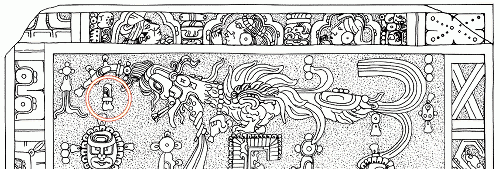The issue with item #6
As it was already mentioned briefly in step 4, there is an issue concerning the item #6, and it is somewhat problematic, whether this element could really have been treated as a triplet during the solution. The item is placed at the top left of the layout, and has the coordinates (−16, 17):
On the Cotterell drawing (which I used originally) the representation was a bit sketchy, and based on this I considered it to be a triplet initially:
But on the (more accurate) Greene drawing it is clearly depicted as something else than a triplet. Although it is similar in size, and also its look resembles that to some extent, yet it is obviously not a triplet:
If we highlight the item and its reflections in the control phase state, we can then see that it is connected to itself at the inward edges of the corner elements:
Thus, without this item, we would have the following layout:
Note: PQLT9506T9596T0496
As we can see, not treating this item as a triplet (and thus not using it in the layout) would not change the solution procedure significantly (or, more precisely, not at all), and, since the corner elements play only a temporary role during the solution, and the other item (#10) in itself is enough to define the edges, all the steps could be performed without any trouble. But it is also obvious, that this item (#6) fits perfectly into the layout, and it seems much more probable (to me at least) that the craftsmen, who actually carved the lid, misinterpreted the plan they were working from (as there are also numerous other signs indicating this), than supposing a mere decorating item with this size and look at this exact position on the drawing. Therefore, this item was treated as a triplet in this document and was included in the layout, although it has no real relevance, whether we accept the assumption about the careless carving, or rather we leave out this element from the process entirely.
Uncertainties
One source of the uncertainties around the solution is the obvious fact that the carvers, who actually created the lid, had absolutely no idea of any code hidden in the pattern. They evidently paid no real attention to the triplets and the star symbols, and did not care for making those of equal size or even straight aligned. They clearly must have carried out their work based on some plan or design in front of them, and they had concentrated on the figures that they thought to be of importance, whereas the triplets and the stars did not get the attention they would have deserved. But the designers of the code seem to have anticipated this problem initially, and designed into the procedure a control phase that apparently serves the very purpose of giving an opportunity to correct the inaccuracies introduced during the engraving (or any other copying) process. With the help of this control state we were indeed able to compensate for the carving problems completely (hopefully), and as the superimposition of the normalized layout over the lid drawing shows, we did not have to modify any of the items' positions in a dramatic way either.
Another uncertainty factor during the solution was (a bit surprisingly) the quite large discrepancy between the different drawings made from the pattern of the lid. I have already mentioned on this page (and before) some of the many tiny inconsistencies between the Cotterell and the Greene drawings, which had an impact on the solution process itself too, but during the research I have encountered even larger and (to be honest) hardly understandable divergences (as for example on the Wikipedia version of the lid the face on the right side has 4 "inner planets" and not 3). The Greene drawing appears to be the most accurate and careful, and also the Cotterell picture (that I used initially) fortunately turned out to be precise enough to serve as a basis for the solution. Moreover, rather luckily, even the inaccuracies of the latter (like the issue with item #6, or the corners' shape in step 2) proved to be beneficial as hints during the process. It is, by the way, absolutely not impossible that the sketchier Cotterell drawing is in fact closer to the original plan than the Greene version, which itself scrupulously reproduces all the errors introduced during the carving procedure.
Finally, a lot of doubt may naturally come into one's mind regarding the solution presented in this document because of its fantasticality and novelty. Even if the code does exist and the message was decoded (more or less) correctly, its topic alone (an ancient interstellar travel) and the fact that it would be the very first of its kind known to us, could create much skepticism. Furthermore, the encoding method is so unique and peculiar that we don't even possess the necessary theoretical framework yet that could enable us to verify its integrity and correctness. I myself did everything I could to reduce these uncertainties to the extent possible, but obviously there is still a lot of work that needs to be done in order to obtain at least a reasonable assurance concerning the code and its assumed solution.




